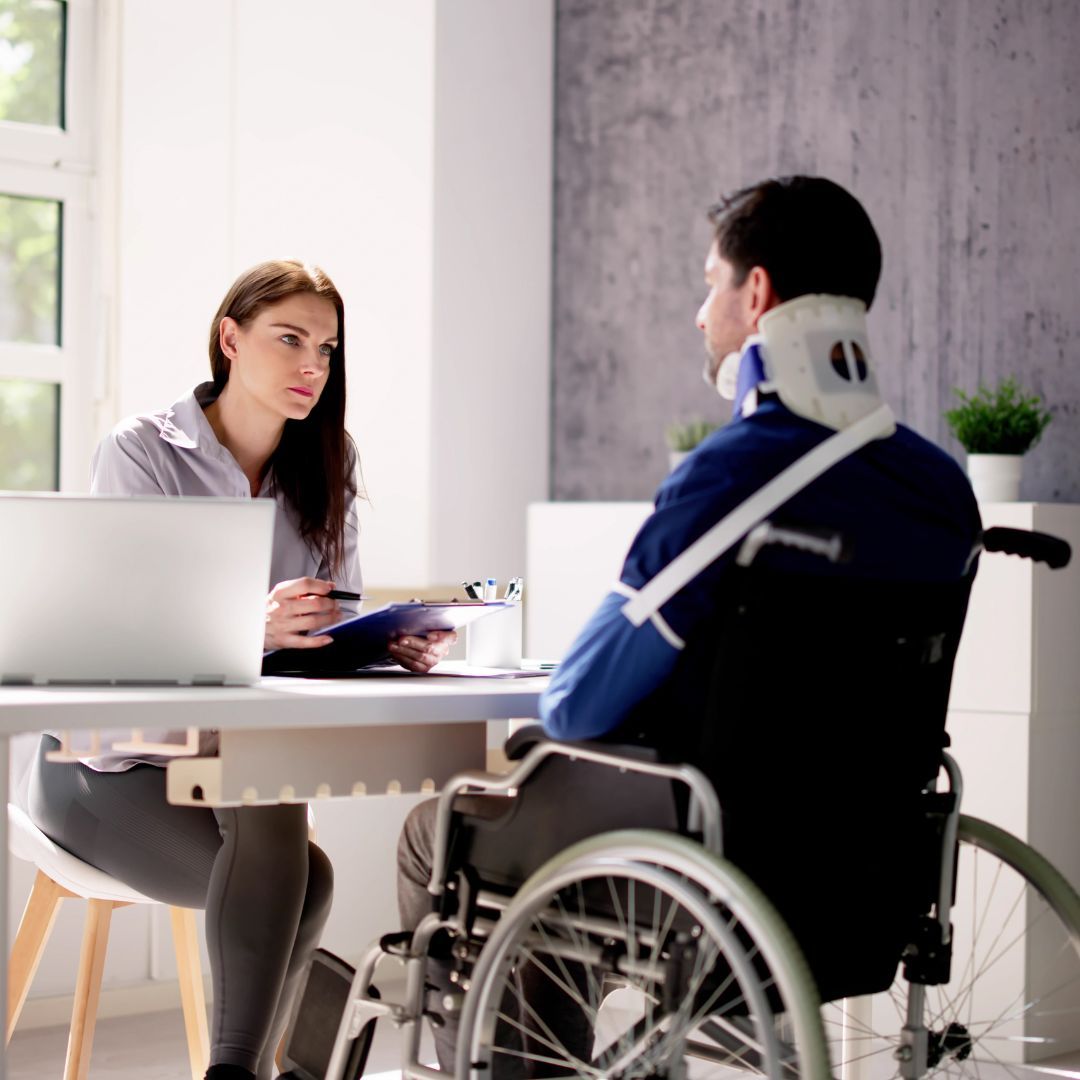Worker Compensation Insurance for LVN workers
Index
Understanding Workers' Comp Insurance
California's Workers' Comp Insurance Laws
How to Obtain Workers' Comp Insurance in California
Costs Associated with Workers' Comp Insurance
Filing a Workers' Comp Insurance Claim in California
Contact Us
Phone
886-226-4436
Location
9340 Bolsa Ave, Westminster, CA 92683
Workers Comp By City
In the dynamic and demanding world of healthcare, Licensed Vocational Nurses (LVNs) occupy a vital niche, providing hands-on care and emotional support to patients in hospitals, clinics, long-term care facilities, and private homes. Yet, with the privilege of assisting those in need comes the inherent risk of workplace injuries and illnesses. Worker compensation insurance serves as the foundational safety net that ensures LVNs receive timely wage replacement and medical benefits when they sustain work-related harm. Crafting a comprehensive, tailored workers’ compensation program for LVN professionals not only mitigates financial exposure for employers but also reinforces the agency’s commitment to the health, safety, and morale of its frontline caregivers. In this extensive exploration, we delve into the multifaceted dimensions of worker compensation insurance for LVN workers—examining regulatory frameworks, unique occupational perils, premium structures, claims management strategies, and the broader cultural and economic dividends of a robust safety infrastructure.
Understanding Workers’ Compensation Insurance for LVNs
At its core, workers’ compensation insurance operates on a no-fault principle: when an LVN is injured or becomes ill due to job duties, the system provides predefined benefits without requiring proof of employer negligence. This exchange—guaranteed prompt assistance in return for the employee’s waiver of litigation rights—facilitates swift access to medical care, wage replacement for lost work time, and, when necessary, vocational rehabilitation services. For LVNs, whose daily responsibilities often involve patient transfers, injections, IV line management, and monitoring critical vital signs, the risk of musculoskeletal strains, needlestick injuries, and infectious disease exposure looms large. A tailored compensation policy anticipates these hazards, offering coverage parameters designed to expedite recovery, reduce administrative friction, and uphold the professional dignity of these essential caregivers.
The No-Fault Principle and Its Implications
The no-fault mechanism inherent in workers’ compensation eliminates the adversarial, protracted litigation process traditionally associated with tort claims. LVNs benefit from immediate authorization of medically necessary treatment, supported by prearranged fee schedules and provider networks that reduce out-of-pocket expenses and avoid coverage disputes. From an employer’s perspective, this system streamlines the resolution of claims and limits potential legal costs. However, success under a no-fault regime depends on rigorous adherence to statutory reporting requirements and accurate classification of injury events. Agencies must train supervisors and HR personnel to recognize reportable incidents, complete incident reports promptly, and secure necessary medical documentation. Failure to comply with state deadlines or to capture critical details—such as the mechanism of injury, treating providers, and any workplace witnesses—can jeopardize claim acceptance and delay benefit disbursement, undermining the very efficiencies the no-fault model promises.
Why LVN Workers Require Specialized Coverage
Although general healthcare workers’ compensation programs offer a baseline of protection, the distinct scope of an LVN’s duties calls for specialized policy provisions. Unlike registered nurses or allied health professionals, LVNs frequently perform tasks under the direct supervision of physicians or RNs, often in resource-constrained settings. In hospital wards, these nurses may respond to emergency codes, transfer patients from wheelchairs, and manage wound dressings under tight time pressures. In home-care scenarios, LVNs navigate unpredictable environments—slippery bathroom floors, uneven thresholds, or cluttered living areas—while delivering injections or changing catheter bags. A comprehensive compensation package for LVNs should therefore account for elevated rates of back and shoulder injuries, provide expedited coverage for bloodborne pathogen exposures, and include allowances for ergonomic equipment or safe-lift machinery when available. Moreover, psychological impacts—stemming from exposure to traumatic patient events or the emotional toll of end-of-life care—underscore the need for integrated mental health services within the policy framework.
State and Federal Regulatory Considerations
Workers’ compensation is primarily governed at the state level, with each jurisdiction prescribing its own mandates for coverage thresholds, benefit schedules, and administrative procedures. For LVN employers operating in multiple states, understanding the nuances of each system is indispensable. Certain states categorize home health and personal care professionals under specialized “home care carve-outs,” which may impose different premium rates or claim definitions than hospital-based classifications. Other states require employers to carry coverage for all part-time and contract LVNs, irrespective of payroll volume. At the federal level, statutes such as the Occupational Safety and Health Act (OSHA) impose overarching duties to maintain workplaces free of recognized hazards, compelling employers to implement safety protocols and training that can influence compensation claim frequencies. Additionally, Medicaid and Medicare funding formulas increasingly tie reimbursement rates to workforce stability and safety metrics, indirectly incentivizing providers to maintain low injury rates and robust compensation programs that support rapid return to work.
Identifying Unique Occupational Hazards for LVNs
A meticulous hazard assessment forms the foundation of any effective workers’ compensation strategy. For LVNs, common perils include manual patient lifts, needlestick incidents, slip-and-fall events, and exposure to hazardous substances or infectious diseases. Even routine tasks—such as turning a bedridden patient—can precipitate cumulative trauma disorders if performed repeatedly without proper body mechanics or assistive devices. LVNs engaged in home-care assignments encounter additional dangers: unsecured rugs, poorly lit stairways, or unpredictable household pets. Infection control challenges—ranging from contact with methicillin-resistant Staphylococcus aureus (MRSA) lesions to airborne pathogens—demand rigorous use of personal protective equipment and adherence to isolation protocols. Recognizing these multifarious risks, agencies can devise targeted interventions: mandating safe-lift teams for bariatric patients, providing sharps disposal systems, enforcing standardized house-call checklists, and equipping caregivers with telehealth access for real-time guidance when complications arise.
Designing an Effective Coverage Plan
Translating the risk profile of LVNs into an insurance policy requires collaboration between employers, risk managers, and carriers. The design process encompasses setting appropriate deductible levels, selecting between guaranteed-cost and retrospective rating options, and negotiating experience modification factors reflective of the agency’s safety record. A low deductible may elevate premium outlay but minimize claim delays and encourage reporting of minor incidents before they escalate. Conversely, a higher deductible can reduce upfront costs while incentivizing the agency to resolve smaller claims internally. Retrospective rating allows final premium adjustments based on actual loss experience, aligning financial outcomes with safety performance. Coupling workers’ compensation with other liability coverages—such as professional liability for scope-of-practice disputes—can yield economies of scale in administrative overhead and potential bundle discounts. Crucially, policy terms must explicitly define LVN scopes of practice, clarify coverage for clinical supervision activities, and stipulate mental health counseling provisions, ensuring comprehensive protection across the full spectrum of clinical duties.
Calculating Premiums: Payroll, Classification Codes, and Experience Modifiers
Accurate premium determination hinges on three interrelated variables: total payroll, classification codes, and the experience modification factor. Payroll figures translate directly into exposure units, reflecting the aggregate hours LVNs spend on duty. Classification codes, assigned by the National Council on Compensation Insurance or equivalent bodies, differentiate rates for non-medical home health aides, vocational nurses, and other categories. LVNs typically fall under specific healthcare codes that carry higher average loss costs than administrative or clerical staff. The experience modification factor adjusts the pure premium upward or downward based on historical claims data relative to industry peers; an agency with fewer and less severe claims earns a factor below one, engendering premium relief, whereas persistently high claims elevate the modifier and amplify premium obligations. Advanced rating plans can integrate deposit premium arrangements—where preliminary premiums undergo post-audit adjustments—to ensure that final costs mirror actual payroll and claim outlays. For LVN employers, maintaining precise payroll records, enforcing accurate job code assignments, and rigorously contesting erroneous modifier adjustments are critical to preserving favorable premium rates.
Understanding Worker Compensation Insurance
At its core, worker compensation insurance is a no-fault system designed to streamline the process by which employees injured at work receive benefits, irrespective of who is at fault. This structure eliminates the need for protracted litigation in most cases, offering both employers and employees a predictable framework for addressing workplace injuries. For LVNs, who frequently engage in tasks that carry heightened risk—such as lifting and transferring patients or administering injections—this insurance mitigates financial uncertainty. Under typical worker compensation policies, benefits cover medical expenses, temporary disability payments for lost wages, permanent disability compensation if injuries result in lasting impairment, and death benefits for the families of LVNs who die as a result of workplace incidents. Beyond statutory requirements, these policies can be customized with optional endorsements, such as rehabilitation support, vocational retraining, and coverage for both psychiatric and post-traumatic stress conditions, which are particularly relevant for nurses facing traumatic patient care situations.
Why LVN Workers Need Specialized Coverage
While worker compensation insurance applies broadly to many professions, LVNs require specialized considerations due to the nature of their work. The classification codes used by insurance carriers group LVNs under healthcare support, but within this category, the frequency and severity of claims tend to exceed those of less physically demanding occupations. Consequently, insurers may require more detailed underwriting for LVN exposures, factoring in the care setting—whether acute care, long-term care, or home health—and patient acuity levels. For instance, an LVN working in a hospital’s intensive care unit may face different risks than one providing home visits to geriatric patients. Specialized coverage may include enhanced medical expense limits to cover complex procedures, allowances for third-party patient aggression, and provisions for travel-related injuries when LVNs drive between multiple client homes. Tailoring policies in this way ensures that agencies maintain compliance with state mandates while capturing the full spectrum of LVN exposures.
Legal and Regulatory Requirements
The legal architecture governing worker compensation insurance varies by state, but all jurisdictions mandate some form of coverage for employers with at least one employee. For LVN agencies, noncompliance can trigger severe penalties, including substantial fines, criminal charges, and liability for all benefits due, which can amount to several times the normal insurance premium. Agencies must register with their state’s worker compensation board or department, file proof of insurance annually, and maintain accurate payroll records for classification and premium calculation. In some states, healthcare providers—including those employing LVNs—must obtain separate approvals or filings for self-insurance programs, captive insurance arrangements, or large deductible plans. Furthermore, the Federal Employees’ Compensation Act (FECA) may apply if LVNs work for federal healthcare facilities, requiring distinct coverage protocols. Staying abreast of legislative changes, such as expansions in psychiatric injury definitions or modifications to wage replacement caps, is crucial for agencies to ensure both LVN protection and organizational compliance.
Calculating Premiums for LVN Coverage
Premium determination for worker compensation insurance hinges on two principal factors: the total payroll for LVN employees and the experience modification rate (EMR), which reflects an agency’s claims history relative to industry peers. The base rate per payroll dollar is derived from classification codes assigned by the National Council on Compensation Insurance (NCCI) or state rating bureaus. For LVNs, these rates tend to be higher than for clerical staff, owing to the inherent physical risks of nursing care. Agencies with frequent or severe claims face elevated EMRs, which can increase premiums by 20%, 50%, or more compared to a neutral modifier of 1.0. Conversely, exemplary safety records yield EMRs below 1.0, translating into premium discounts. Other variables impacting premiums include state-based rate differentials, actuarial trends in medical costs, return-to-work program effectiveness, and the selected policy deductible or retention level. By engaging in proactive safety programs and partnering with insurers on loss-control initiatives, agencies can influence their EMR and, over time, reduce their total insurance expenditure.
Coverage Components and Benefits
A standard worker compensation policy for LVNs encompasses multiple benefit categories. Medical benefits cover all reasonable and necessary treatment related to the workplace injury, including hospital stays, surgeries, medications, physical therapy, and medical devices. Temporary disability benefits generally replace a percentage (commonly two-thirds) of the LVN’s average weekly wage, subject to statutory maximums and minimums, until they can return to work. If an injury results in permanent impairment, permanent partial disability benefits compensate for the loss of function according to a state-specific impairment schedule. In tragic instances where an LVN’s injury leads to death, death benefits provide funeral expenses and ongoing support to eligible dependents. Many policies also offer supplemental benefits, such as coverage for vocational rehabilitation—vital for LVNs who require retraining after debilitating injuries—and allowances for travel costs when seeking specialized medical services. Agencies may negotiate higher benefit limits or broader coverage for emerging concerns like long-term mental health conditions stemming from workplace stress.
Claims Process for LVNs
Efficient handling of worker compensation claims is critical to minimize disruptions for both LVNs and agencies. Upon an injury, the LVN must report the incident promptly—often within a narrow statutory window—to their supervisor, who then initiates the employer’s claim filing. Insurers typically require completion of an incident report, medical provider statements, and wage verification forms. A claims adjuster is assigned to manage the case, coordinating medical evaluations, approving treatments, and calculating benefit entitlements. Agencies benefit from adopting streamlined digital claims platforms, which can reduce paperwork, expedite approvals, and enhance transparency. Throughout the claims lifecycle, proactive communication with the LVN is paramount to support their recovery, address questions, and gauge readiness for modified duty. For incidents involving potential liability beyond worker compensation—such as patient assault—agencies must collaborate with legal and risk management teams to separate third-party claims from worker compensation procedures. Proper documentation of all medical visits, work restrictions, and communication ensures smoother claims resolution and helps guard against fraud or appeal challenges.
Risk Management Strategies
Effective risk management sits at the intersection of preventing workplace injuries and mitigating the severity of those that occur. For LVN agencies, comprehensive safety programs should include regular hazard assessments across care settings—from identifying fall risks in patient rooms to evaluating ergonomics in lifting tasks. Training modules on safe patient handling techniques, proper use of personal protective equipment, and infection control protocols reduce exposure to injury and illness. Additionally, implementing incident reporting systems that encourage near-miss documentation allows agencies to identify patterns before they result in harm. Leadership must also foster a safety culture in which LVNs feel empowered to voice concerns, request ergonomic support, and participate in safety committees. Engagement with insurers’ loss-control services—such as on-site consultations and safety audit tools—enables targeted interventions and validates best practices. When agencies embed these strategies into everyday operations, they not only curb claim frequency but also cultivate trust and mutual accountability with LVNs.
Scope of Worker Compensation Insurance in the Healthcare Sector
Worker compensation insurance is mandated by statute in every U.S. jurisdiction for organizations that employ a certain number of workers, though thresholds and exemptions vary by state. Within the healthcare sector, LVNs typically qualify as covered employees because they engage in clinical duties that carry inherent risks. This insurance program extends beyond simple accident coverage; it encompasses all occupationally induced physical injuries and illnesses, including musculoskeletal disorders from patient handling, needlestick injuries, chemical exposures, and mental health conditions precipitated by workplace stressors. For LVNs, whose responsibilities may shift between acute care hospitals, long-term care facilities, home health agencies, and outpatient clinics, the insurance must account for the diverse settings in which care is delivered. Consequently, policy underwriters assess not only the clinical tasks performed but also the environments—staircases in patient homes, slick floors in surgical units, cramped spaces on hospital wards—that exacerbate risk. A robust worker compensation policy for LVNs, therefore, reflects an understanding of both the occupational dangers intrinsic to nursing and the variability of care settings.
Regulatory Landscape Governing Worker Compensation Insurance for LVN Workers
The legal framework underpinning worker compensation insurance arises from a blend of federal mandates and state statutes. While federal legislation establishes broad principles—such as prohibitions on retaliation against injured workers and minimum benefit standards—it is state laws that delineate specific coverage requirements, benefit calculations, and dispute resolution mechanisms. For LVNs, this regulatory patchwork directly influences insurance program design. Some states set the weekly wage replacement benefit at two-thirds of the employee’s average weekly wage, subject to maximum caps that are periodically adjusted. Other states mandate additional vocational rehabilitation services and explicitly recognize occupational mental health conditions, such as post-traumatic stress disorder following critical incidents. Moreover, the classification of LVNs for premium calculation purposes can differ by jurisdiction, with some states grouping them alongside higher-risk healthcare professions. Employers must remain vigilant regarding legislative updates—whether a state eliminates thresholds for small employers, tightens return-to-work requirements, or expands compensable conditions—so that their insurance coverage and internal policies remain compliant and protective.
Risk Exposures Unique to LVN Roles
LVN workers face a constellation of hazards that inform the underwriting and cost of worker compensation insurance. Among the most prevalent are musculoskeletal injuries incurred during patient transfers and repositioning. Even with mechanical lifts, improper techniques or emergencies can lead to sprains, strains, and chronic back problems. Exposure to biohazards—bloodborne pathogens like hepatitis or HIV, respiratory viruses such as influenza, or antibiotic-resistant bacteria—presents both acute and long-term health risks. Needlestick injuries, while often minor in physical terms, can carry grave psychological stress until testing confirms the absence of infection. Slip-and-fall incidents on wet floors or in cluttered hallways compound the probability of fractures and head injuries. Additionally, LVNs regularly confront emotional and psychological strain, whether from patient suffering, high mortality rates in critical care units, or workplace violence in psychiatric or emergency settings. These multifaceted exposures underscore why insurers meticulously evaluate workplace safety programs and why employers must invest in preventive measures to reduce claim frequency and severity.
Designing an Effective Worker Compensation Insurance Program for LVNs
Crafting a specialized worker compensation insurance program for LVNs entails collaboration between healthcare administrators, human resources professionals, risk managers, and insurance brokers. The process begins with a thorough risk assessment: analyzing incident reports to identify common injury types, reviewing staffing patterns to detect fatigue-related exposures, and inspecting care settings for environmental hazards. This diagnostic phase guides policy selection, determining appropriate coverage limits, deductible layers, and inclusion of supplementary benefits such as extended rehabilitation services or counseling for workplace trauma. Employers may opt for guaranteed cost policies, which offer stable premiums, or disadvantage alternative arrangements like large-deductible programs if they possess sophisticated risk management infrastructures. In either case, the insurance product must align with the agency’s budgetary constraints while ensuring LVNs receive timely medical care and wage replacement benefits. Importantly, insurers often incentivize proactive safety programs through premium credits or experience modification adjustments, making investment in training and infrastructure a cost-effective strategy.
Premium Determination and Cost Considerations
The financial calculus underlying worker compensation premiums for LVN workers hinges on several interrelated factors. Insurers calculate expected losses by examining an employer’s historical claim data, the inherent risk classification of LVNs, anticipated payroll levels, and the jurisdiction’s statutory benefit parameters. The experience modification rate (EMR) serves as a critical lever: organizations with superior loss histories enjoy favorable EMRs, which translate directly into lower premiums, while those with adverse claim records face surcharges. Beyond historical data, insurers evaluate the presence of ergonomic equipment, adherence to infection control protocols, and the robustness of return-to-work programs. Employers can manage costs by negotiating group policies through associations or captive insurance arrangements, pooling risks with similar entities to stabilize premiums. Budgeting further requires forecasting potential claim volatility, allocating reserves for self-insured retentions, and balancing the trade-off between higher deductibles and premium savings. A holistic approach integrates actuarial insight with on-the-ground safety initiatives, ensuring that cost containment does not compromise LVN well-being.
Claims Management and Reporting Protocols
Effective claims management for LVNs is predicated on prompt, accurate reporting and compassionate, transparent communication. When an injury or occupational illness occurs, the LVN must notify their supervisor immediately, and the employer must document the incident comprehensively. This documentation encompasses a narrative of events, witness accounts, any photographic evidence of environmental hazards, and the LVN’s signed statement. Timely submission of claims to the insurance carrier—often within stringent statutory windows—prevents penalties and ensures swift access to medical benefits. The designated claims coordinator acts as the linchpin, liaising with caregivers, medical providers, adjusters, and vocational specialists. Throughout the process, maintaining an open dialogue with the injured LVN—providing regular updates, explaining benefit entitlements, and facilitating return-to-work discussions—fosters trust and mitigates adversarial disputes. Advanced claims management platforms enable real-time tracking of claim status, expense forecasting, and trend analysis, equipping employers and insurers with the data needed to refine prevention strategies and reduce claim duration.
Risk Management and Loss Prevention Strategies
Preventing injuries among LVN workers demands a culture of safety that permeates every organizational layer. Leadership must champion risk reduction by allocating resources to evidence-based interventions. Mandatory training programs should cover safe patient handling techniques, proper use of mechanical lifts, infection control procedures, and de-escalation tactics for handling aggressive behavior. Simulation labs and competency assessments reinforce learning and identify skill gaps before caregivers face real-world scenarios. Routine environmental audits—conducted by interdisciplinary teams of nursing staff, facilities managers, and safety officers—uncover hazards such as obstructed egress routes, inadequate lighting, or malfunctioning equipment. Near-miss reporting systems encourage LVNs to report potential dangers without fear of reprisal, yielding invaluable insights into latent system failures. Data from incident reports, when analyzed for root causes, can spotlight systemic issues—like understaffing or equipment shortages—allowing targeted interventions. Insurers often provide loss control consultants who offer on-site evaluations and recommendations, aligning employer initiatives with industry best practices and regulatory standards.
Return-to-Work and Modified Duty Programs for LVNs
Facilitating the safe and timely reintegration of injured LVNs into the workforce is both a moral imperative and a financial necessity. Return-to-work programs structure transitional assignments that respect medical restrictions while leveraging the caregiver’s existing skill set. For example, an LVN recovering from a lower-back strain might initially perform chart audits or patient education sessions rather than direct lifting tasks. Collaboration with treating physicians ensures that work modifications—such as limits on hours standing, weight restrictions, or avoidance of high-stress environments—are adhered to. Regular check-ins between the LVN, supervisors, and the claims coordinator assess progress and adjust duties accordingly. These programs not only reduce wage replacement costs by minimizing time away from work but also support psychological recovery, as caregivers maintain professional identity and social support. Insurers frequently recognize robust return-to-work initiatives with lower experience modification adjustments, creating a virtuous cycle of improved outcomes and reduced costs.
Navigating the landscape of worker compensation insurance for Licensed Vocational Nurses (LVNs) requires an in-depth understanding of both the unique risks inherent in nursing roles and the complex insurance mechanisms designed to mitigate those risks. LVNs occupy a critical position in the continuum of patient care, often performing hands-on clinical duties under the supervision of registered nurses and physicians. As such, they are exposed to a variety of workplace hazards—ranging from needlestick injuries and patient handling strain to exposure to infectious diseases—that make comprehensive worker compensation insurance essential. This article offers a detailed exploration of worker compensation insurance tailored specifically to LVN professionals, encompassing the foundational principles of coverage, legal and regulatory obligations, risk assessment methodologies, premium determinants, claims procedures, and emerging trends that are reshaping the way insurance providers and healthcare employers approach LVN risk management.
The Role of Licensed Vocational Nurses and Associated Workplace Risks
Licensed Vocational Nurses fulfill an indispensable role in healthcare settings, providing direct patient care, administering medications, monitoring vital signs, and collaborating with medical teams to execute care plans. Their scope of practice often places them in high-stress situations where rapid decision-making is required, and physical demands can be considerable. Patient transfers and repositioning, repetitive motions, and long hours of standing contribute to musculoskeletal injuries. Simultaneously, LVNs are regularly exposed to bloodborne pathogens and chemical agents through handling medications and diagnostic substances. Understanding these occupational hazards is the first step in identifying the nature and extent of worker compensation insurance coverage required to protect both LVNs and their employers from the financial and operational impact of workplace injuries and illnesses.
Fundamentals of Worker Compensation Insurance
Worker compensation insurance serves as a no-fault system that provides medical benefits, wage replacement, rehabilitation services, and death benefits to employees who sustain work-related injuries or illnesses. For LVNs, this insurance is crucial not only because of the physical intensity of their work but also due to the intangible psychological strains that accompany patient care. Under most state laws, employers are required to carry worker compensation coverage, and failure to maintain compliance can result in significant penalties, legal liabilities, and even criminal sanctions. This insurance operates under the principle that employees relinquish the right to sue their employer for negligence in exchange for the guaranteed benefits offered by the compensation system. Consequently, LVNs receive prompt access to medical care and disability payments without the need to navigate protracted litigation processes.
Legal and Regulatory Framework Governing LVN Worker Compensation
The governance of worker compensation insurance is primarily a state-level responsibility, with each jurisdiction enacting its own statutes and regulations that define coverage requirements, benefit levels, claim procedures, and dispute resolution mechanisms. While the broad contours of minimum medical benefits and wage replacement are consistent, differences emerge in areas such as statutory maximums for temporary total disability, definitions of permanent impairment, and eligibility for vocational rehabilitation services. For LVNs, additional considerations may include licensure board reporting requirements when injuries involve professional misconduct or impairment due to substance use. Furthermore, federal regulations such as the Occupational Safety and Health Act impose supplementary obligations on healthcare employers to maintain safe workplaces, which in turn influence the underwriting process and premium calculations for worker compensation insurance policies.
Key Coverage Components for LVN Worker Compensation Policies
A robust worker compensation insurance policy for LVNs typically encompasses several integral components. First, medical expense coverage ensures payment for necessary treatment, hospitalization, diagnostic tests, and medications arising from a work-related injury or illness. Second, indemnity benefits provide wage replacement, generally calculated as a proportion of the worker’s average weekly wage, subject to statutory minimums and maximums. Third, vocational rehabilitation benefits facilitate retraining or modification of job duties when an LVN’s capacity to return to previous roles is compromised. Fourth, death benefits cover funeral expenses and provide financial support to dependents in the event of a fatal workplace incident. Beyond these primary elements, employers and insurers may negotiate ancillary provisions, such as outpatient physical therapy caps or independent medical examination rights, to tailor coverage to the specific risk profile of their LVN workforce.
Determining Premiums: Risk Factors and Underwriting Criteria
Premium determination in worker compensation insurance is an actuarial science that balances anticipated claim costs against administrative expenses and profit margins. Insurers evaluate a multitude of risk factors when underwriting LVN policies. These include the classification of the nursing occupation, historical loss experience of the employer, payroll volume for LVN staff, geographical location, workplace safety programs, and any prior penalties or compliance infractions. The classification code assigned to LVNs reflects the relative hazard level and corresponding rate per hundred dollars of payroll. Employers with robust safety metrics—such as low incidence rates of lost-time injuries, active employee training programs, and ergonomic initiatives—may qualify for experience modification factors that reduce their premiums. Conversely, employers with a history of frequent or severe claims may face increased rates or stricter policy terms.
Risk Management Strategies to Mitigate LVN Workplace Injuries
Effective risk management is a collaborative endeavor between healthcare employers, LVNs, and insurance carriers. Proactive measures center on identifying potential hazards and implementing controls to minimize injury likelihood. Ergonomic assessments of patient handling procedures, investment in mechanical lift devices, and comprehensive training in body mechanics are critical to reducing musculoskeletal injuries. Needlestick prevention programs, including the use of safety-engineered sharps devices and mandatory compliance audits, address bloodborne pathogen risks. Additionally, mental health support programs and stress management workshops can alleviate the psychological stressors that contribute to burnout and inadvertent errors. When insurers observe a demonstrable commitment to risk mitigation in an agency’s operations, they may extend premium discounts or enhanced coverage options, underscoring the symbiotic relationship between workplace safety and insurance economics.
Navigating the Claims Process: Best Practices for LVNs and Employers
When an LVN sustains a work-related injury or illness, the timeliness and accuracy of the claims process are paramount. Best practices begin with immediate reporting to the employer, followed by prompt notification to the insurer in accordance with statutory deadlines. Employers should maintain standardized claim intake procedures, including documentation of the incident, witness statements, and initial medical evaluations. LVNs are encouraged to seek treatment from approved medical providers and to adhere strictly to prescribed care plans, as deviation may jeopardize benefit eligibility. Insurers, in turn, should assign dedicated claims adjusters to manage each case, facilitate open communication with treating physicians, and coordinate timely benefit disbursement. Early return-to-work programs, in which LVNs transition to modified duties under medical guidance, can significantly reduce indemnity costs and preserve the nurse’s connection to the workforce.
Understanding Statutory Limits and Benefit Calculations
Each state dictates maximum and minimum thresholds for worker compensation benefits, influencing the extent of coverage available to LVNs. Temporary total disability benefits are often capped at a percentage of the statewide average weekly wage, while permanent partial disability awards are apportioned based on impairment rating schedules. Some jurisdictions delineate specific benefit structures for fatal claims, entitling dependents to a statutory number of weeks of wage replacement. LVNs should familiarize themselves with their state’s maximum weekly benefit and duration limits, as well as any special provisions for occupational diseases such as hepatitis or musculoskeletal disorders. Insurance carriers rely on these statutory parameters when estimating loss reserves and projecting long-term liabilities, making benefit calculations a critical factor in policy pricing and financial planning.
Role of Safety Culture in Reducing Workers’ Compensation Costs
Cultivating a robust safety culture is among the most effective strategies for curbing workers’ compensation costs in healthcare settings. When LVNs perceive that leadership prioritizes their well-being, they are more likely to adhere to safe practices and report hazards without fear of reprisal. Safety committees, comprised of management and frontline nursing staff, facilitate continuous dialogue on emerging risks and improvement opportunities. Regular safety drills, transparent incident reporting systems, and recognition programs for safe behaviors reinforce desired conduct. Insurers often incorporate safety culture assessments into their underwriting process, awarding credit for documented programs such as accredited infection control certifications or external safety audits. In the long term, a sustained emphasis on safety not only reduces claim frequency and severity but also enhances employee morale and patient outcomes.
Impact of State-Specific Legislation on LVN Compensation Insurance
Across the United States, divergent state statutes and administrative rules shape the contours of worker compensation insurance for LVNs. For example, some states require reimbursement for travel expenses incurred by home health LVNs, recognizing the travel between patient residences as compensable work time. Others impose premium discounts for health employers who subscribe to state-approved managed care networks or alternative dispute resolution processes. Legislative trends—such as caps on attorney fees in contested claims or modifications to presumption laws for infectious disease—can materially affect claim handling and litigation risk. Healthcare organizations that operate multi-state LVN programs must therefore navigate a matrix of regulatory regimes, ensuring that each policy aligns with local mandates and that administrative protocols accommodate jurisdictional nuances.
What type of insurance do you need for a bar?
For a bar, there are several types of insurance that are typically necessary to protect the business from various risks:
- Liquor Liability Insurance: This is essential for bars as it covers claims related to alcohol service. It helps protect against lawsuits if a patron causes harm or damage after being served alcohol at your bar.
- General Liability Insurance: This covers a wide range of risks, including injuries to customers or employees on your premises. For example, if a customer slips and falls, general liability insurance would help cover medical costs and legal fees.
- Property Insurance: Protects your bar’s physical assets, including the building (if owned) and contents like furniture, equipment, and inventory (such as alcohol, food, etc.) against risks like fire, theft, or vandalism.
- Workers' Compensation Insurance: Required in most areas if you have employees, workers’ comp covers medical expenses and lost wages if an employee gets injured while working at your bar.
- Business Interruption Insurance: This covers lost income if your bar has to close temporarily due to a covered event like a fire or natural disaster.
- Commercial Auto Insurance: If your bar has delivery vehicles (for food or supplies), you will need commercial auto insurance to protect the vehicles and drivers.
- Cyber Liability Insurance: If your bar processes customer data, particularly credit card information, this insurance protects against data breaches or cyberattacks.
- Umbrella Insurance: Provides extra coverage beyond your other insurance policies in case of large claims that exceed the limits of your standard coverage.
Each of these policies helps cover different risks that a bar might face, so it's important to evaluate the specific needs of your bar based on its size, location, and services offered.
How much is insurance for a bar?
The cost of insurance for a bar can vary significantly based on several factors, including:
- Location: The geographic area where the bar is located can affect the cost. Areas with higher risks (such as theft, vandalism, or natural disasters) might lead to higher premiums.
- Size and Revenue: A larger bar with higher revenue or more patrons will typically face higher premiums. This is because there is a greater risk involved in terms of potential accidents or liability claims.
- Type of Insurance: There are various types of insurance a bar might need, including:
- General Liability Insurance: Covers injuries or accidents that happen on the premises.
- Liquor Liability Insurance: Specifically covers incidents related to alcohol consumption.
- Property Insurance: Covers the bar's physical assets, including the building, inventory, and equipment.
- Workers' Compensation Insurance: Required if the bar has employees, covering work-related injuries.
- Claims History: If the bar has a history of claims or accidents, this could increase the cost of insurance.
On average, small to medium-sized bars might pay anywhere from $500 to $2,000 per year for basic coverage, but this can increase significantly based on the factors mentioned above. For example, if you're in a high-risk area or have a larger venue, the cost could be higher. It's best to get quotes from several insurance providers to find the most accurate rate for your specific situation.
Is workers' compensation insurance mandatory for bars and wineries in California?
Yes, California law requires all businesses with employees, including bars and wineries, to carry workers' compensation insurance. This coverage helps pay for medical expenses and lost wages if an employee is injured or becomes ill due to their job.
How can bars and wineries obtain customized insurance coverage?
To obtain tailored insurance coverage:
- Consult with an Insurance Broker: Work with professionals who specialize in the hospitality and beverage industry to assess unique risks and recommend appropriate coverage.
- Regularly Review and Update Policies: As your business grows and evolves, ensure your insurance policies adapt to cover new risks and operations.
REQUEST A QUOTE
Speak with a CA Workers Compensation Insurance specialist today!
Learn More About Workers Comp. Insurance











